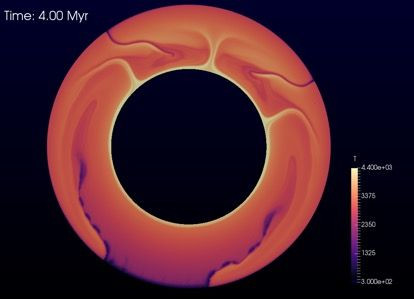How Did Earth Form? Meteorite Crashes Helped Planet Support Life

Earth might be a special world that supports life because it had a rough youth — scientists say our planet’s plate tectonics and the magnetic field that keeps us safe might be the work of meteorites that crashed down more than 4 billion years ago.
Simulations of a young Earth being bombarded with meteorites suggests that large impacts would have caused subduction, in which the outer layer called the crust was forced downward into the mantle, the layer between the crust and the core, according to a study in the journal Nature Geoscience. This process would have resulted in tectonic activity, the movement of the Earth’s crust.
We most notably see tectonic activity today when the plates that make up the crust rub against each other and cause earthquakes. But the movement is crucial to understanding the evolution of Earth’s topography. Plates smashing together can build mountains, and plates receding from one another can create gaps on the surface that become ocean.
It has been unclear, however, whether the first 500 million years of Earth’s existence included tectonic activity. The computer simulations add to that conversation.
When the meteorites from the Hadean period, between 4 billion and 4.56 billion years ago, pummeled young Earth and caused subduction, “this would have effectively recycled large portions of the Earth’s surface, drastically changing the geography of the planet,” lead study author Craig O’Neill said in a statement from Macquarie University.
The crust being pushed down into the Earth would have also caused an “upwelling” of the mantle, in which molten material moves toward the surface, driving volcanic activity.
And there are even more goodies coming from ancient meteorites. It would have been that same sort of subduction process that spawned the magnetic field around the planet that acts as a shield against harmful radiation and the intensity of the solar wind, the stream of charged particles that are blown in our direction from the sun.
“Large impact events may have also kick-started the Earth’s magnetic field by triggering the planet’s cold outer crust to suddenly move downward and interact with the Earth’s outer core,” O’Neill said. “This affects convection in the core, and thus the geodynamo — the process that creates the Earth’s magnetic field.”
The computer simulations show us something about early Earth that can be hard to see, since there isn’t much crust leftover from the Hadean period that scientists can study.
“We’ve seen evidence of some geological activity that suggests something like subduction acted on the early Earth — but this is hard to reconcile with other geodynamic simulations,” O’Neill said. “But if we consider Earth as part of an evolving early solar system, as opposed to only looking at the planet in isolation, then this evolution starts to make more sense.”
If the computer simulations do indeed paint an accurate picture of young Earth, plate tectonics and the planet’s magnetic field would be just another two advancements in the evolution of the world that we can attribute to space rocks. Previous research suggests that asteroids and comets delivered organic material and water to Earth, making it possible for life to begin.
“One has to wonder, how much of the current Earth, and other terrestrial planets, is the result of collisions that took place eons ago?” coauthor Simone Marchi, from the Southwest Research Institute, said in the statement.
© Copyright IBTimes 2024. All rights reserved.





















